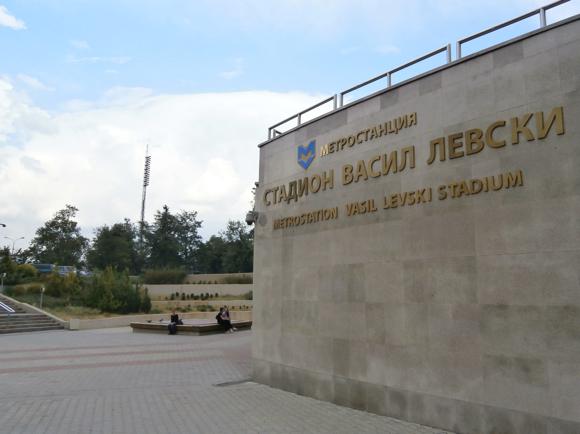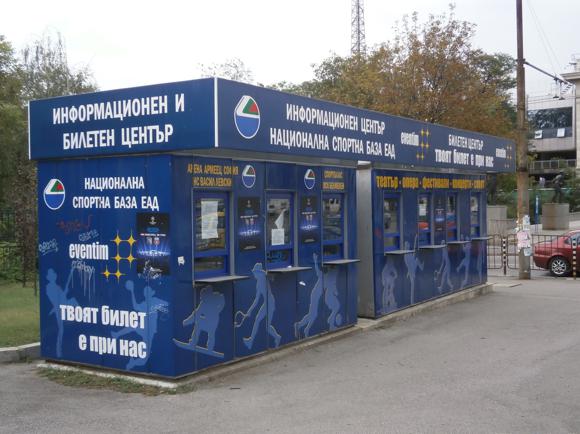The field of dreams – and the stands around it
Set in a leafy corner of south-east Sofia, Bulgaria’s national stadium, the Vasil Levski, still feels like a classic, Communist-era sports arena.
It was built from 1949 on the original pitch of the preeminent side of the pre-war era, Levski Sofia. Then an open field on the city outskirts, this was the main football ground in town until war broke out.
Created in Stalinist style, grand and Neo-Classical, the Vasil Levski was officially unveiled exactly four months after the Soviet dictator’s death in 1953.

It was named after a tragic revolutionary hero of the 19th century, Vasil Levski – as, originally, had Levski Sofia, the first football team to play in the new stadium. Then re-named Dinamo, they took on FC Wien of Vienna in a friendly.
Also used for athletics meetings and all kinds of indoor sports, Bulgaria’s national arena could hold a capacity of 42,000. By the 1960s, and the arrival of crowd-pleasing stars such as Gundi Asparoukhov and Dimitar Yakimov, the Vasil Levski came to life on European nights. It was here that Asparoukhov’s Levski took on Eusébio’s Benfica and Yakimov’s CDNA played Herrera’s Internazionale in a European Cup semi-final.
Renovated in 1966, with an upper tier added, the Vasil Levski staged Bulgarian internationals and cup finals, and usually the Eternal Derby between Levski and CSKA, whatever their name that particular season.

The most memorable meeting between the two came in 1985, a cup final between the Big Two that ended in an all-in brawl. Both clubs were temporarily dissolved and a handful of players received lifetime bans, including a then teenage Hristo Stoichkov.
Modernised in 2002 and renovated again in 2012, the Vasil Levski remains an open bowl, with a running track, the lower rows with poorer visibility.
Levski Sofia fans have always occupied the South Stand, Sector B. CSKA, whose own Bulgarian Army Stadium is a short walk across the park, are allocated the North Stand, Sector G. Sector A, alongside the main road of bulevard Evlogi i Hristo Georgiev, is the only roofed one and contains the VIP and press areas.
For Ludogorets games, the away sector is usually between the A and G sectors, close to where CSKA fans would be.
getting there
Going to the stadium – tips and timings


The Vasil Levski has its own metro station on red metro line 1, two from central Serdika and by mid-2015 direct from Sofia Airport. If you’re coming straight in from the airport, bus 84 terminates close to the stadium.
It’s also on tramlines 10, 12 and 18 but as there’s little public transport in the city centre itself, walking or metro are the best options.
getting in
Buying tickets – when, where, how and how much

Ticket prices for domestic fixtures are kept low, a few euros at most. See the entries for individual clubs for their details.
You’ll find a large blue information and ticket kiosk in the concourse of the main entrance of the stadium. The cheapest tickets will be behind the goals in B (‘Б’) and G, the most expensive in A.
The Bulgarian-language FA website has no details of international matches or tickets. Visiting fans should their individual FAs for ticket details.
Where to Drink
Pre-match beers for fans and casual visitors


As the stadium is at the edge of the sprawling Borisova Gradina park, there is no shortage of restaurants, cafés and plain booths selling beer nearby. Between Orlov Most bridge and the stadium, by the Ariana pond, are half-a-dozen spots where fans gather before the match. Most work year-round.
On the other side of the stadium is a smaller park dominated by the tall Soviet Army memorial. Here several other establishments include the popular if nameless terrace that everyone refers to as Baba Yaga, open warmer months only.
Tucked inside the façade of the main entrance, the Sportna Sreshta café offers Kamenitza beer and plenty of football talk.




